A 28 GHz 2 × 2 Antenna Array with 10 Beams Using Passive SPDT Switch Beamforming Network
Abstract
:1. Introduction
2. Working Principle of the Proposed Antenna System
3. Measured S-Parameters
4. Radiation Patterns of the Proposed Antenna System
4.1. Simulated Switched Beams
4.2. Feed Network for Radiation Patterns Measurements
4.3. Measured Radiation Patterns
4.4. Comparison and Discussion
5. Conclusions
Author Contributions
Funding
Institutional Review Board Statement
Informed Consent Statement
Conflicts of Interest
References
- Niu, Y.; Li, Y.; Jin, D.; Su, L.; Vasilakos, A. A Survey of Millimeter Wave (mmWave) Communications for 5G: Opportunities and Challenges. Wirel. Netw. 2015, 21, 2657–2676. [Google Scholar] [CrossRef]
- Bshara, O.; Liu, Y.; Begashaw, S.; Dandekar, K.R. Computational electromagnetic simulation and performance analysis of reconfigurable antennas for outdoor 60 GHz applications. In Proceedings of the 2017 IEEE Radio and Wireless Symposium (RWS), Phoenix, AZ, USA, 15–18 January 2017; pp. 38–41. [Google Scholar] [CrossRef]
- Topak, E.; Hasch, J.; Wagner, C.; Zwick, T. A Novel Millimeter-Wave Dual-Fed Phased Array for Beam Steering. IEEE Trans. Microw. Theory Tech. 2013, 61, 3140–3147. [Google Scholar] [CrossRef] [Green Version]
- Khalily, M.; Tafazolli, R.; Rahman, T.A.; Kamarudin, M.R. Design of Phased Arrays of Series-Fed Patch Antennas with Reduced Number of the Controllers for 28-GHz mm-Wave Applications. IEEE Antennas Wirel. Propag. Lett. 2016, 15, 1305–1308. [Google Scholar] [CrossRef] [Green Version]
- Ehyaie, D.; Mortazawi, A. A 24-GHz Modular Transmit Phased Array. IEEE Trans. Microw. Theory Tech. 2011, 59, 1665–1672. [Google Scholar] [CrossRef]
- Hong, W.; Jiang, Z.H.; Yu, C.; Zhou, J.; Chen, P.; Yu, Z.; Zhang, H.; Yang, B.; Pang, X.; Jiang, M.; et al. Multibeam Antenna Technologies for 5G Wireless Communications. IEEE Trans. Antennas Propag. 2017, 65, 6231–6249. [Google Scholar] [CrossRef]
- Foglia Manzillo, F.; Nastri, R.; Spella, M.; Gentile, G.; Spirito, M. A 60-GHz Passive Broadband Multibeam Antenna System in Fused Silica Technology. IEEE Antennas Wirel. Propag. Lett. 2013, 12, 1376–1379. [Google Scholar] [CrossRef]
- Luo, Q.; Gao, S.; Liu, W.; Gu, C. Low-Cost Smart Antennas, 1st ed.; Microwave and Wireless Technologies Series; Wiley: Hoboken, NJ, USA, 2019. [Google Scholar]
- Foglia Manzillo, F.; Śmierzchalski, M.; Le Coq, L.; Ettorre, M.; Aurinsalo, J.; Kautio, K.T.; Lahti, M.S.; Lamminen, A.E.I.; Säily, J.; Sauleau, R. A Wide-Angle Scanning Switched-Beam Antenna System in LTCC Technology with High Beam Crossing Levels for V-Band Communications. IEEE Trans. Antennas Propag. 2019, 67, 541–553. [Google Scholar] [CrossRef]
- Yang, Q.L.; Ban, Y.L.; Kang, K.; Sim, C.Y.D.; Wu, G. SIW Multibeam Array for 5G Mobile Devices. IEEE Access 2016, 4, 2788–2796. [Google Scholar] [CrossRef]
- Wu, Q.; Hirokawa, J.; Yin, J.; Yu, C.; Wang, H.; Hong, W. Millimeter-Wave Multibeam Endfire Dual-Circularly Polarized Antenna Array for 5G Wireless Applications. IEEE Trans. Antennas Propag. 2018, 66, 4930–4935. [Google Scholar] [CrossRef]
- Cheng, Y.J.; Hong, W.; Wu, K. Millimeter-Wave Substrate Integrated Waveguide Multibeam Antenna Based on the Parabolic Reflector Principle. IEEE Trans. Antennas Propag. 2008, 56, 3055–3058. [Google Scholar] [CrossRef]
- Hall, P.; Vetterlein, S. Review of radio frequency beamforming techniques for scanned and multiple beam antennas. IEE Proc. Microwaves Antennas Propag. 1990, 137, 293. [Google Scholar] [CrossRef]
- Dutta, S.; Barati, C.N.; Ramirez, D.; Dhananjay, A.; Buckwalter, J.F.; Rangan, S. A Case for Digital Beamforming at mmWave. IEEE Trans. Wirel. Commun. 2020, 19, 756–770. [Google Scholar] [CrossRef] [Green Version]
- Ghani, F.A.; Uzun, A.; Saleh, H.A.; Yapici, M.K.; Tekin, I. A 28 GHz 2 × 2 Antenna Array with 10 Beams Using Passive Beamforming Network. In Proceedings of the 2020 IEEE International Symposium on Antennas and Propagation and North American Radio Science Meeting, Montreal, QC, Canada, 5–10 July 2020; pp. 1747–1748. [Google Scholar] [CrossRef]
- Orakwue, S.I.; Ngah, R.; Rahman, T.A. A two dimensional beam scanning array antenna for 5G wireless communications. In Proceedings of the 2016 IEEE Wireless Communications and Networking Conference Workshops (WCNCW), Doha, Qatar, 3–6 April 2016; pp. 433–436. [Google Scholar] [CrossRef]
- Shin, G.S.; Kim, J.S.; Oh, H.M.; Choi, S.; Byeon, C.W.; Son, J.H.; Lee, J.H.; Kim, C.Y. Low Insertion Loss, Compact 4-bit Phase Shifter in 65 nm CMOS for 5G Applications. IEEE Microw. Wirel. Components Lett. 2016, 26, 37–39. [Google Scholar] [CrossRef]
- Lee, W.; Kim, J.; Yoon, Y.J. Compact Two-Layer Rotman Lens-Fed Microstrip Antenna Array at 24 GHz. IEEE Trans. Antennas Propag. 2011, 59, 460–466. [Google Scholar] [CrossRef]
- Remez, J.; Zeierman, E.; Zohar, R. Dual-Polarized Tapered Slot-Line Antenna Array Fed by Rotman Lens Air-Filled Ridge-Port Design. IEEE Antennas Wirel. Propag. Lett. 2009, 8, 847–851. [Google Scholar] [CrossRef]
- Liu, Y.; Bshara, O.; Tekin, I.; Dandekar, K.R. A 4 by 10 series 60 GHz microstrip array antenna fed by butler matrix for 5G applications. In Proceedings of the 2018 IEEE 19th Wireless and Microwave Technology Conference (WAMICON), Sand Key, FL, USA, 9–10 April 2018; pp. 1–4. [Google Scholar] [CrossRef] [Green Version]
- Cao, Y.; Chin, K.S.; Che, W.; Yang, W.; Li, E.S. A Compact 38 GHz Multibeam Antenna Array with Multifolded Butler Matrix for 5G Applications. IEEE Antennas Wirel. Propag. Lett. 2017, 16, 2996–2999. [Google Scholar] [CrossRef]
- Chen, C.J.; Chu, T.H. Design of a 60-GHz Substrate Integrated Waveguide Butler Matrix—A Systematic Approach. IEEE Trans. Microw. Theory Tech. 2010, 58, 1724–1733. [Google Scholar] [CrossRef]
- Yang, Q.; Gao, S.; Luo, Q.; Wen, L.; Ban, Y.L.; Ren, X.; Wu, J.; Yang, X.; Liu, Y. Millimeter-Wave Dual-Polarized Differentially Fed 2-D Multibeam Patch Antenna Array. IEEE Trans. Antennas Propag. 2020, 68, 7007–7016. [Google Scholar] [CrossRef]
- Yan, S.P.; Zhao, M.H.; Ban, Y.L.; Lian, J.W.; Nie, Z. Dual-Layer SIW Multibeam Pillbox Antenna with Reduced Sidelobe Level. IEEE Antennas Wirel. Propag. Lett. 2019, 18, 541–545. [Google Scholar] [CrossRef]
- Gong, R.J.; Ban, Y.L.; Lian, J.W.; Liu, Y.; Nie, Z. Circularly Polarized Multibeam Antenna Array of ME Dipole Fed by 5 × 6 Butler Matrix. IEEE Antennas Wirel. Propag. Lett. 2019, 18, 712–716. [Google Scholar] [CrossRef]
- Artemenko, A.; Mozharovskiy, A.; Maltsev, A.; Maslennikov, R.; Sevastyanov, A.; Ssorin, V. Experimental Characterization of E-Band Two-Dimensional Electronically Beam-Steerable Integrated Lens Antennas. IEEE Antennas Wirel. Propag. Lett. 2013, 12, 1188–1191. [Google Scholar] [CrossRef]
- Ala-Laurinaho, J.; Aurinsalo, J.; Karttunen, A.; Kaunisto, M.; Lamminen, A.; Nurmiharju, J.; Räisänen, A.V.; Säily, J.; Wainio, P. 2-D Beam-Steerable Integrated Lens Antenna System for 5G E-Band Access and Backhaul. IEEE Trans. Microw. Theory Tech. 2016, 64, 2244–2255. [Google Scholar] [CrossRef]
- Khajeim, M.F.; Moradi, G.; Shirazi, R.S.; Zhang, S.; Pedersen, G.F. Wideband Vertically Polarized Antenna with Endfire Radiation for 5G Mobile Phone Applications. IEEE Antennas Wirel. Propag. Lett. 2020, 19, 1948–1952. [Google Scholar] [CrossRef]
- PE42525 Ultra CMOS® SPDT RF Switch from Peregrine Semiconductor. Available online: http://www.psemi.com/products/rf-switches/broadband-rf-switches/pe42525 (accessed on 20 October 2021).
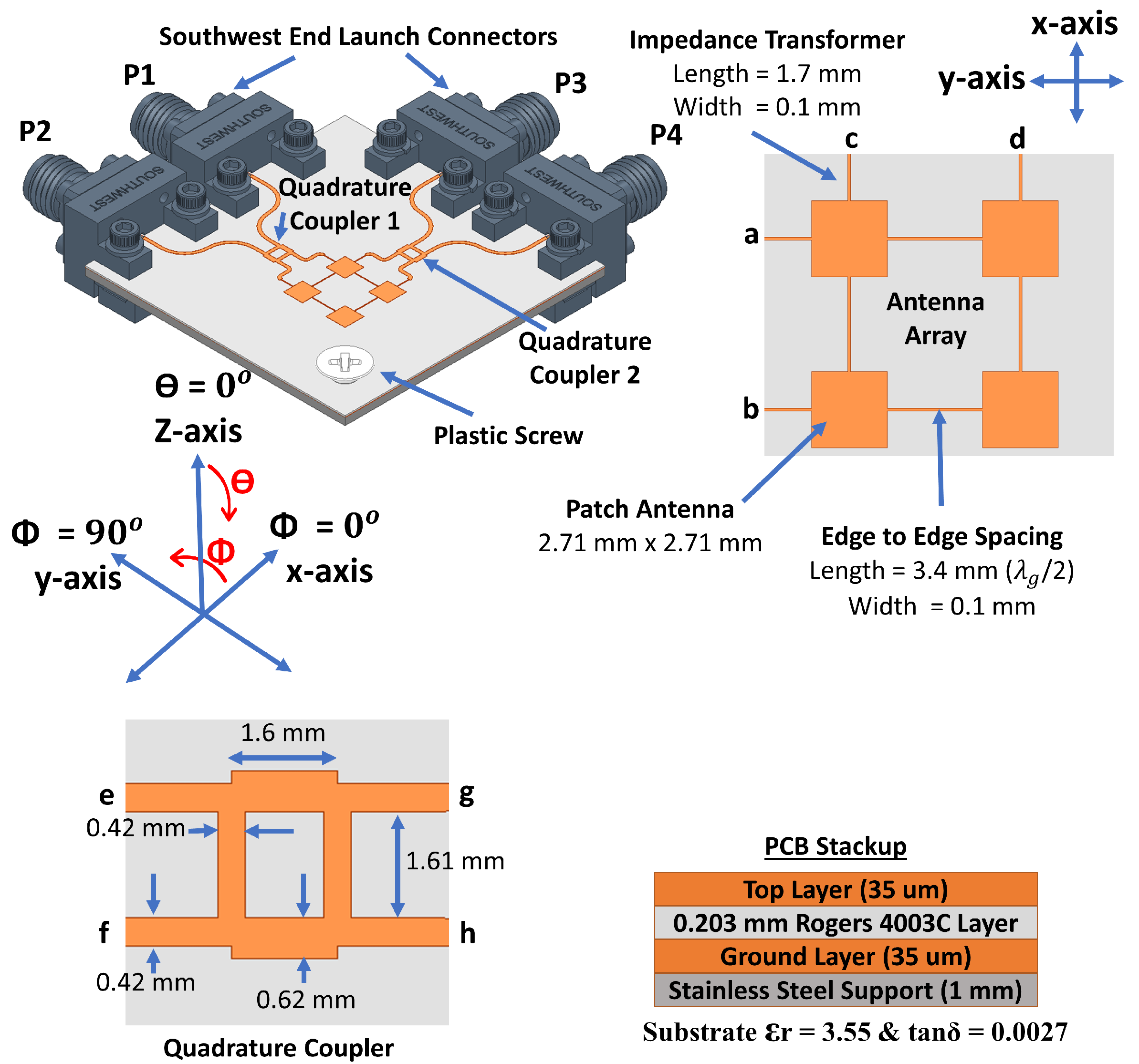
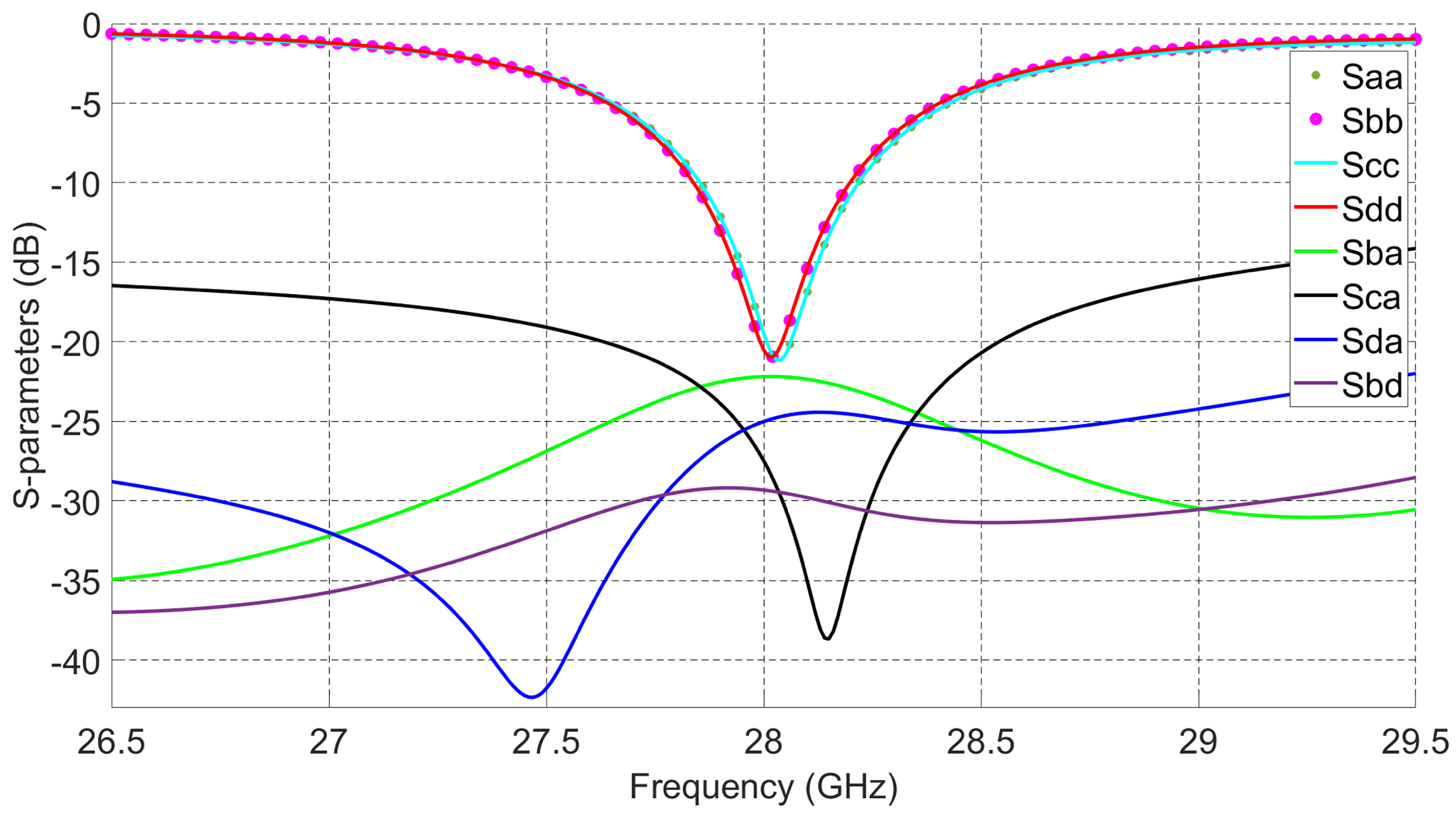
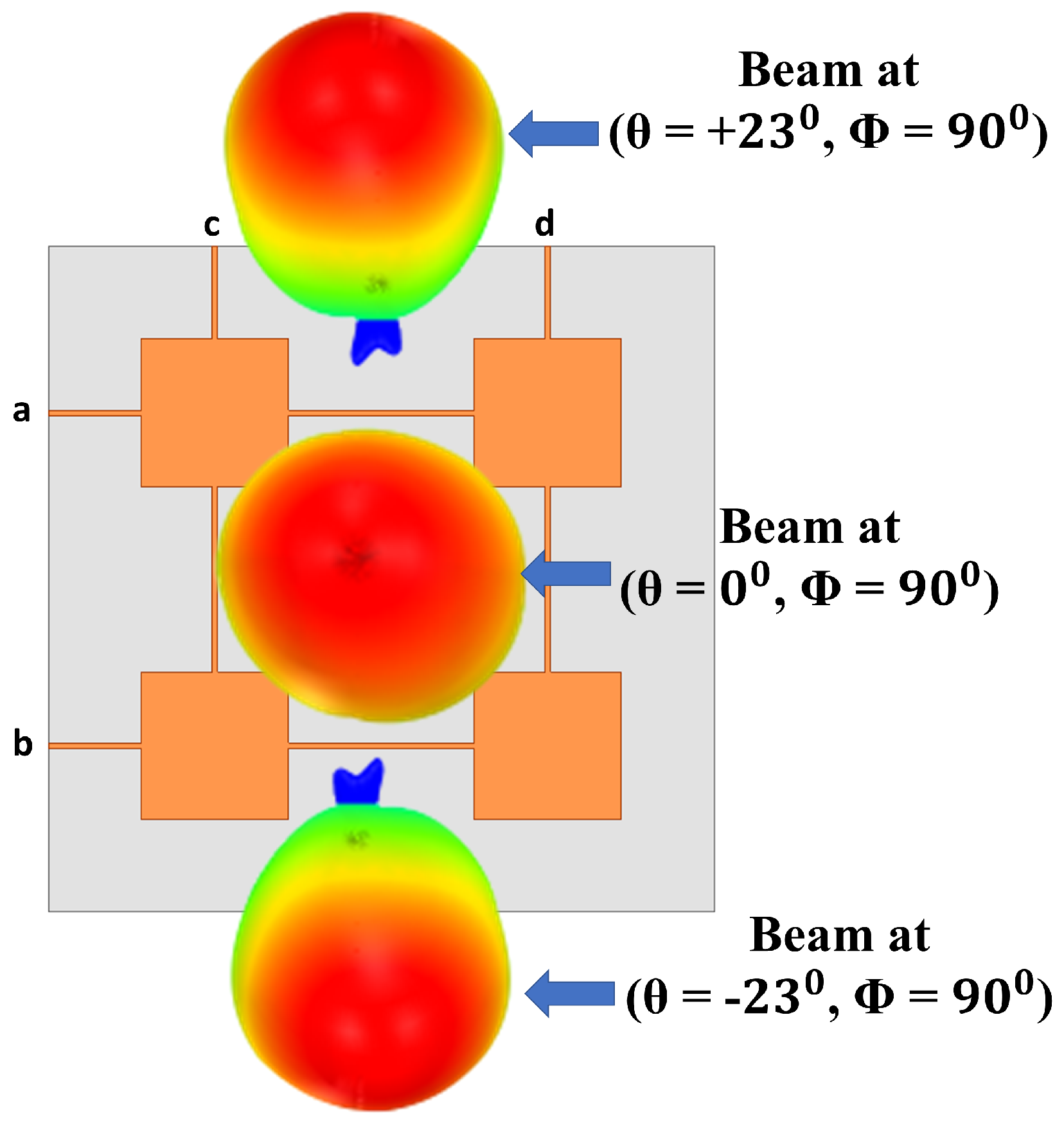

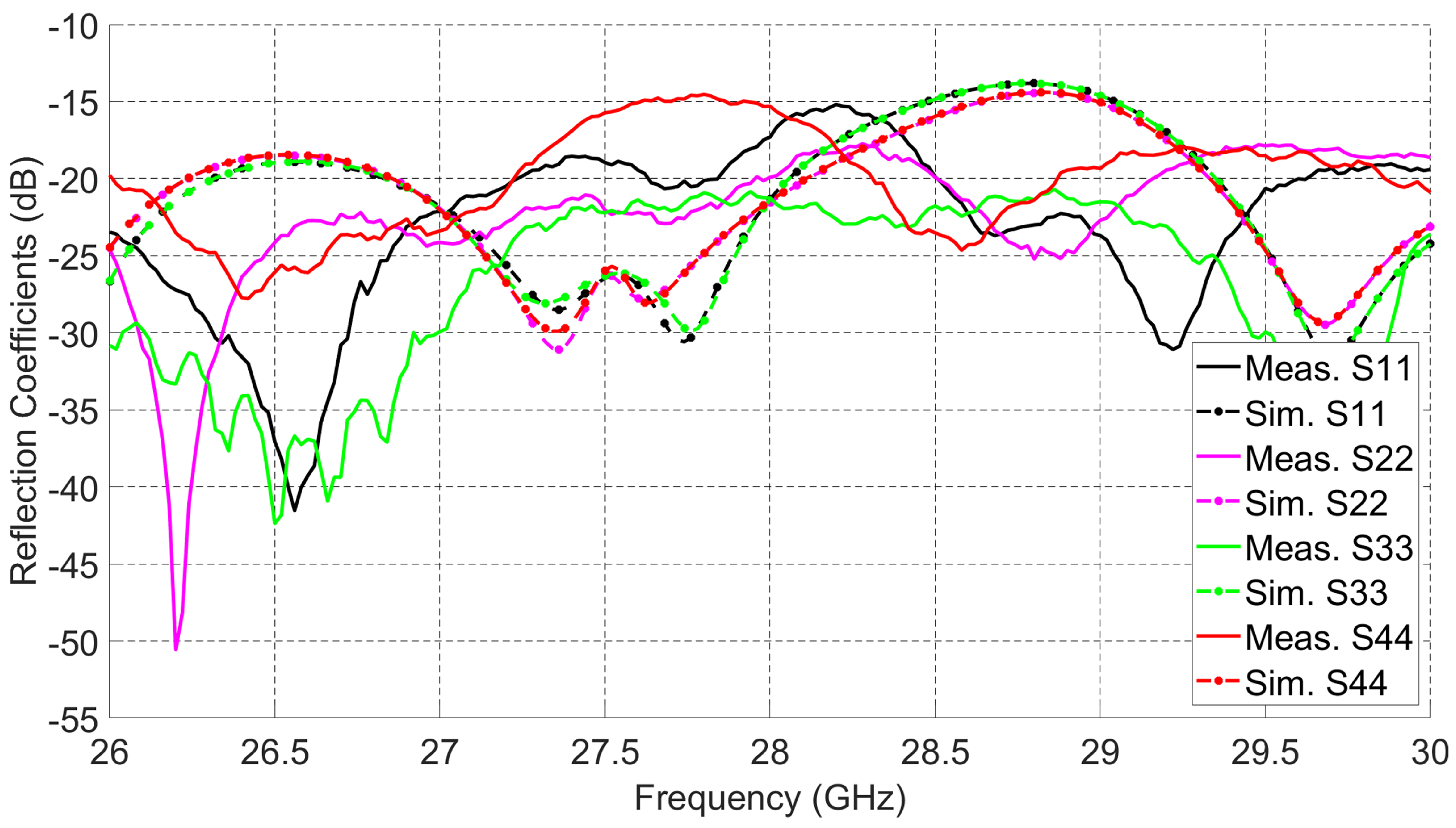
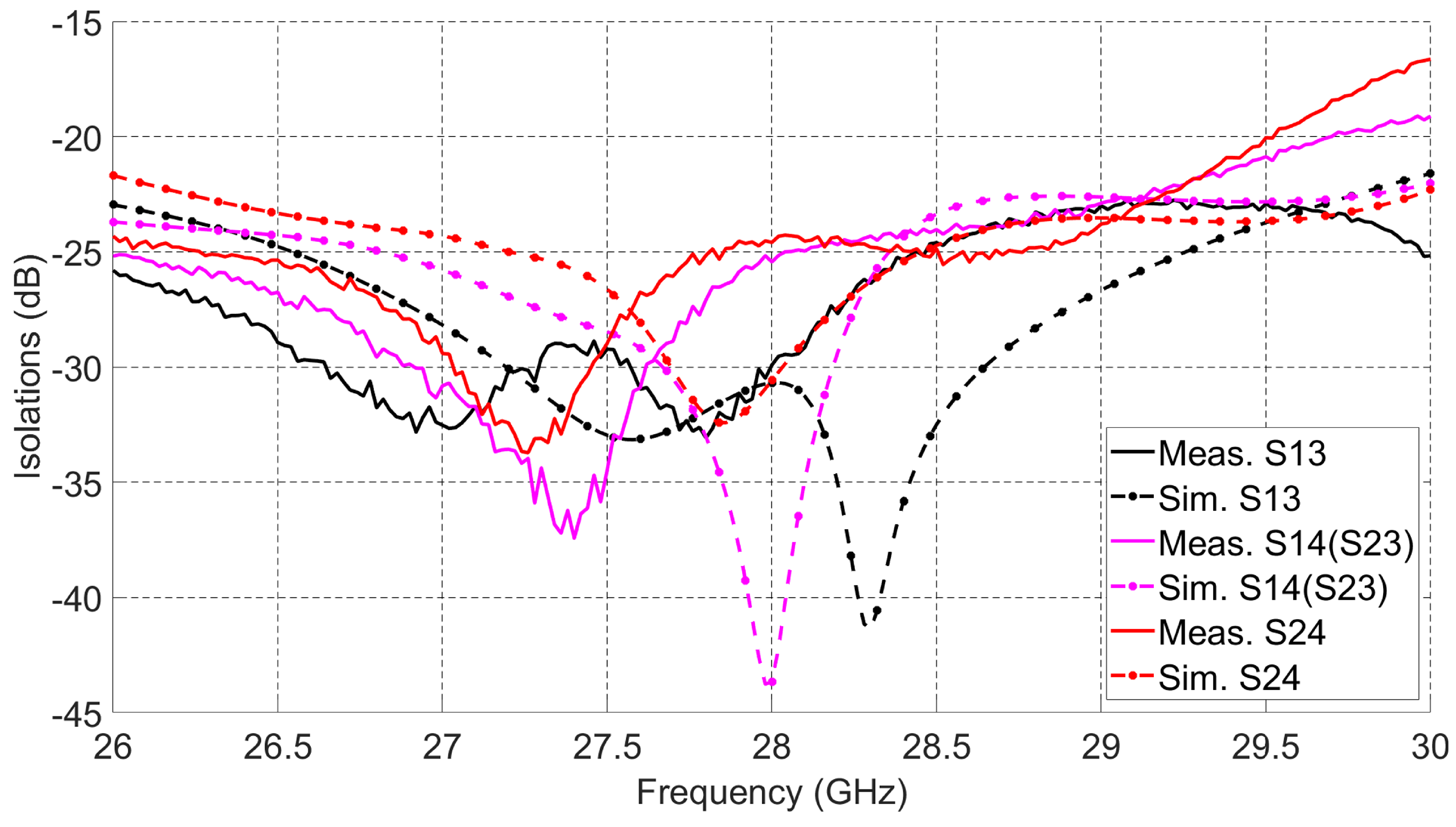
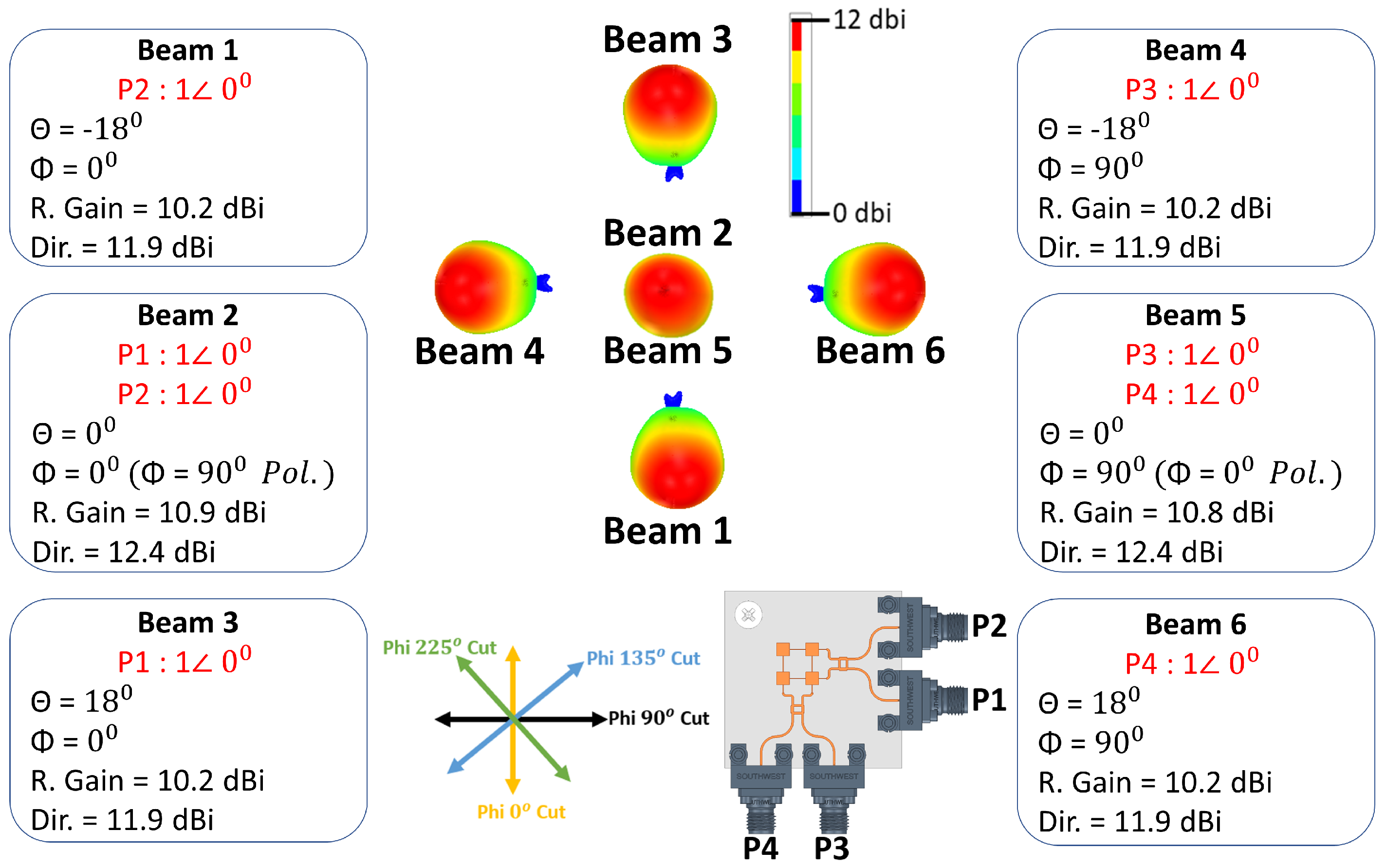
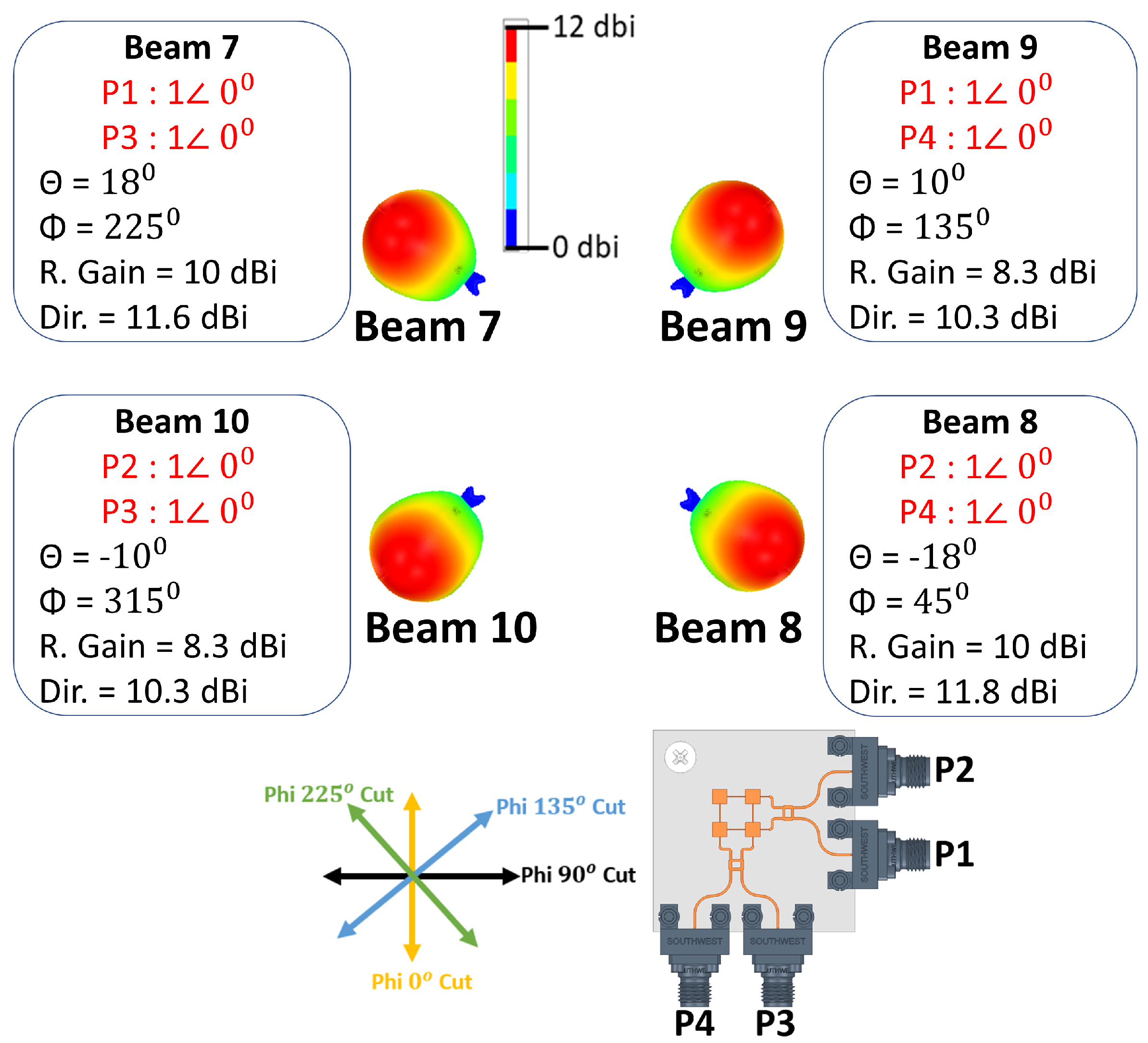
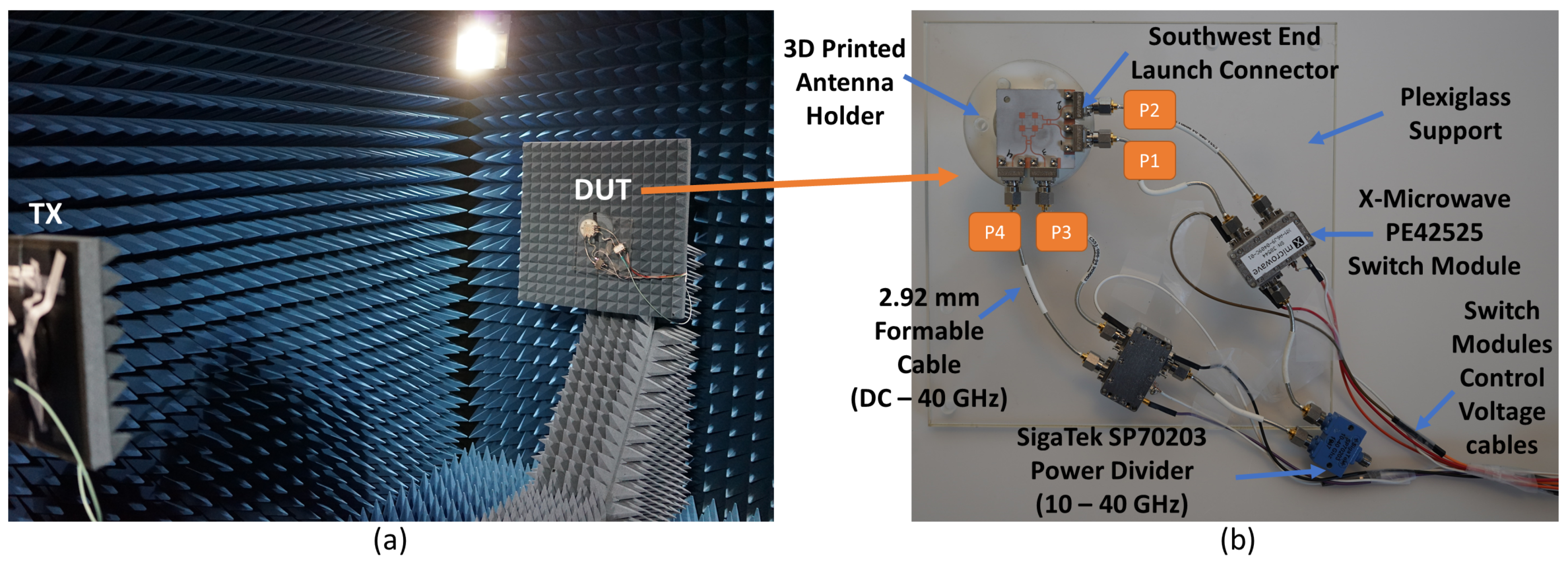

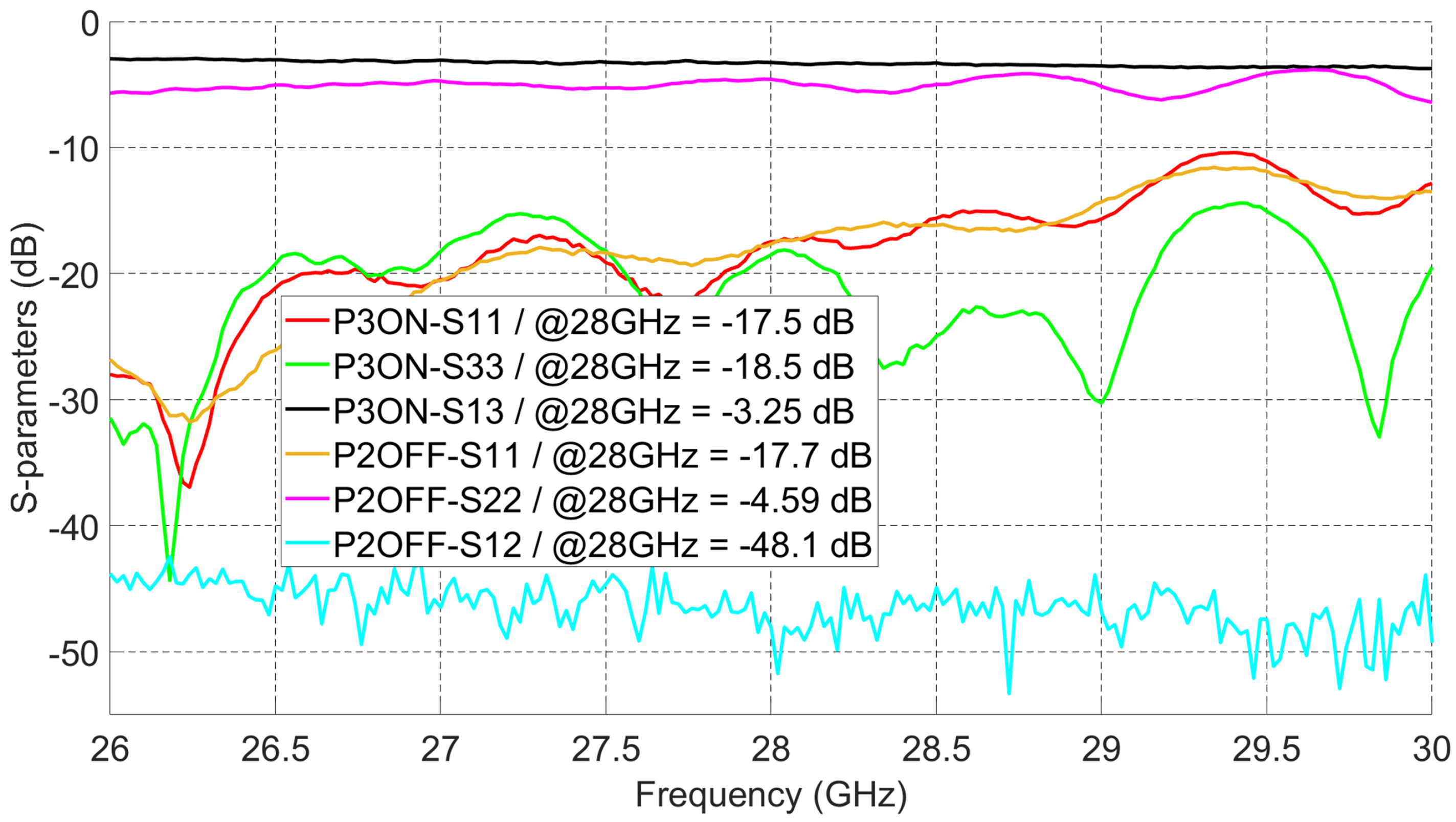
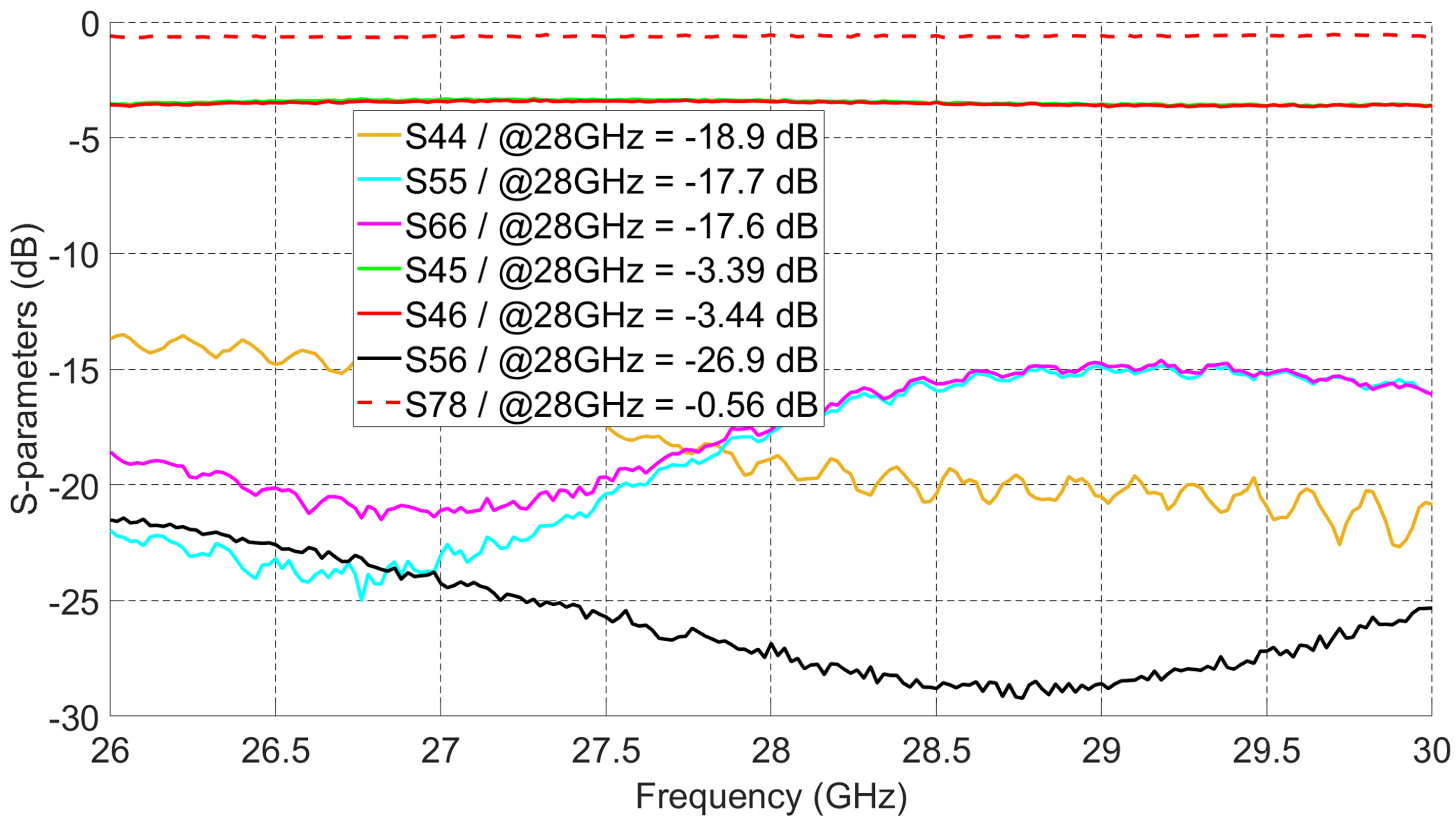

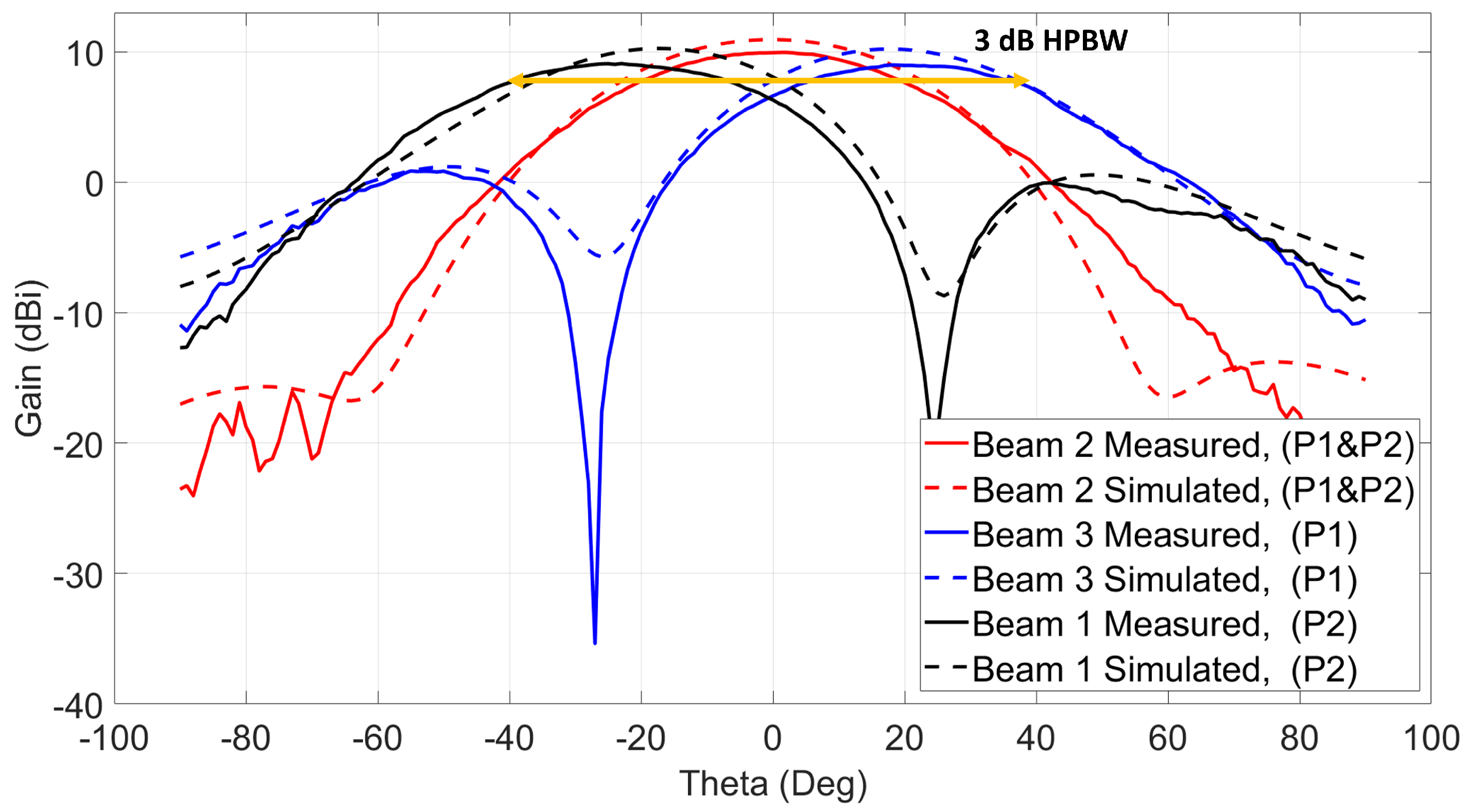


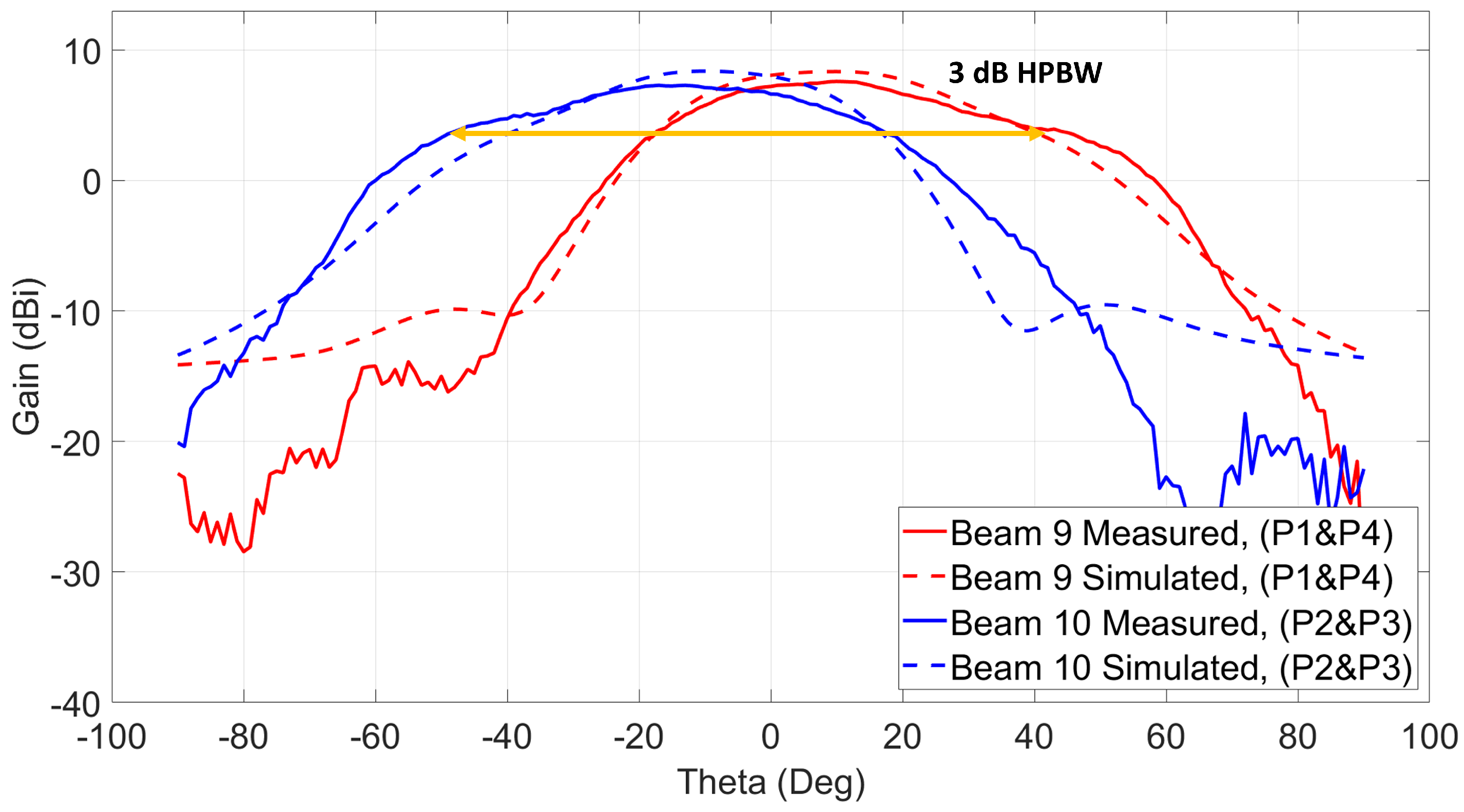

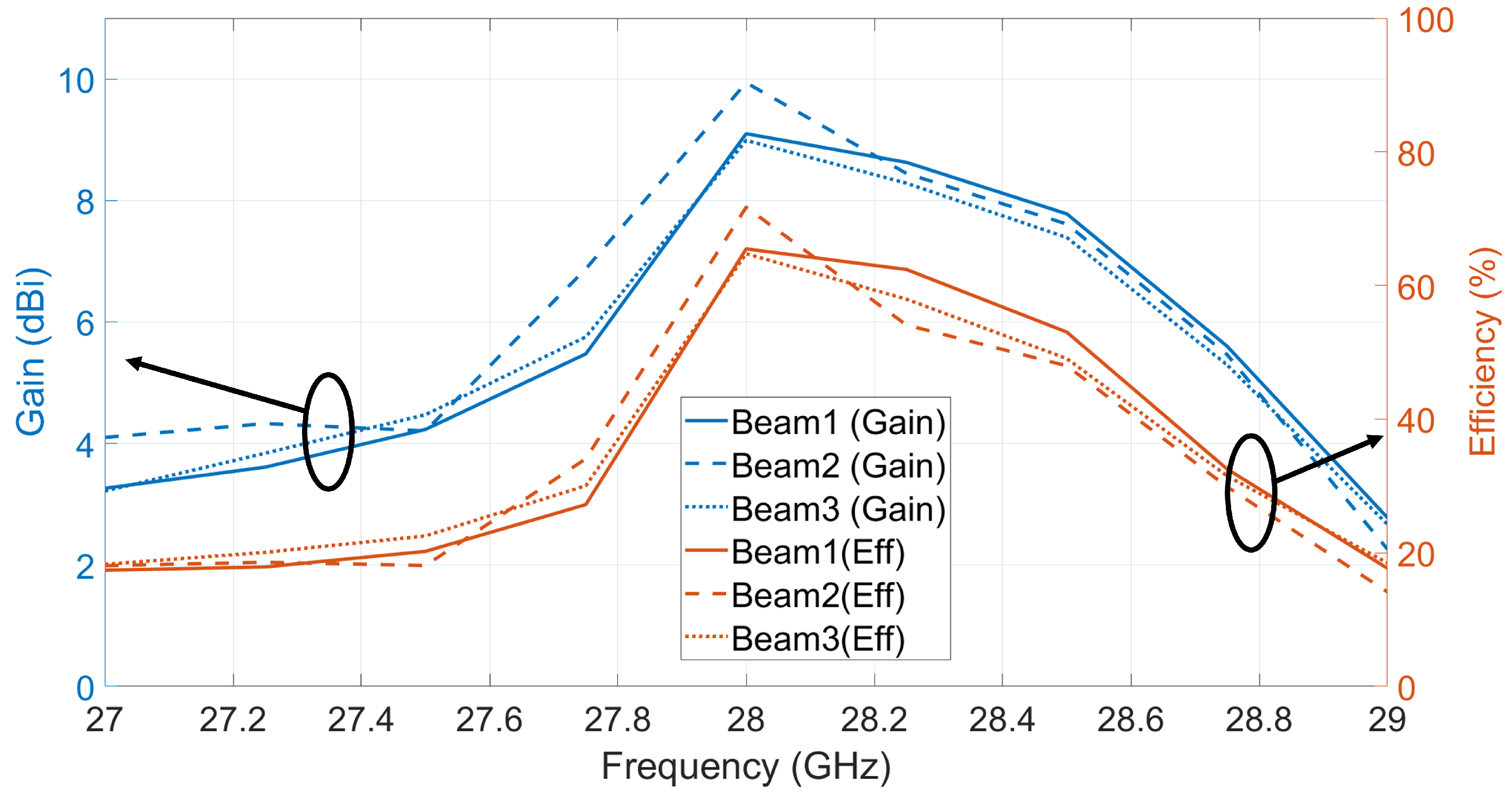
| Coupler 1 | Coupler 2 | Beam No. | ||
|---|---|---|---|---|
| P1 | P2 | P3 | P4 | |
| OFF | ON | OFF | OFF | Beam 1 |
| ON | ON | OFF | OFF | Beam 2 |
| ON | OFF | OFF | OFF | Beam 3 |
| OFF | OFF | ON | OFF | Beam 4 |
| OFF | OFF | ON | ON | Beam 5 |
| OFF | OFF | OFF | ON | Beam 6 |
| ON | OFF | ON | OFF | Beam 7 |
| OFF | ON | OFF | ON | Beam 8 |
| ON | OFF | OFF | ON | Beam 9 |
| OFF | ON | ON | OFF | Beam 10 |
| Beam No. | Excited Port/s | Theta () | Phi () | Measured Gain (dBi) |
|---|---|---|---|---|
| 1 | P2 | −26 | 0 | 9.1 |
| 2 | P1 and P2 | 0 | 0 | 9.9 |
| 3 | P1 | 26 | 0 | 8.9 |
| 4 | P3 | −25 | 90 | 9.1 |
| 5 | P3 and P4 | 0 | 90 | 9.8 |
| 6 | P4 | 25 | 90 | 9.1 |
| 7 | P1 and P3 | 17 | 225 | 8.8 |
| 8 | P2 and P4 | −17 | 225 | 8.9 |
| 9 | P1 and P4 | 17 | 135 | 7.6 |
| 10 | P2 and P3 | −17 | 135 | 7.1 |
| Ref. | Layer Technology | Antenna and Topology | Frequency (GHz) | Beam Coverage Angle | Number of Beams | Average Measured Gain (dBi) | Polarization |
|---|---|---|---|---|---|---|---|
| [4] | Single Layer | Phase Shifters + 2 × 2 Array | 28 | ±24 | 5 | 12 | Dual |
| [18] | Multi-Layer Slot | Rotman Lens + 7 × 4 Array | 24 | ±30 | 5 | / | Single |
| [21] | Multi-Layer SIW | Butler Matrix + 8 × 10 Array | 38 | ±36 | 4 | 19.8–21 | Single |
| [23] | Multi-Layer SIW | Butler Matrix + 2 × 2 Array | 28 | ±30 | 8 | 10 | Dual |
| [24] | Multi-Layer SIW | Butler Matrix + 2 × 7 Array | 28 | ±45 | 5 | 13.2 | Single |
| [25] | Multi-Layer SIW | Butler Matrix + ME Dipole Array | 28 | ±40 | 5 | 12.5 | Circular |
| This work | Single Layer | Simple Feed + 2 × 2 Array | 28 | ±26 | 10 | 8.9 | Dual |
Publisher’s Note: MDPI stays neutral with regard to jurisdictional claims in published maps and institutional affiliations. |
© 2021 by the authors. Licensee MDPI, Basel, Switzerland. This article is an open access article distributed under the terms and conditions of the Creative Commons Attribution (CC BY) license (https://creativecommons.org/licenses/by/4.0/).
Share and Cite
Abdul Ghani, F.; Najafabadi, A.M.A.; Saleh, H.; Kaya Yapici, M.; Tekin, I. A 28 GHz 2 × 2 Antenna Array with 10 Beams Using Passive SPDT Switch Beamforming Network. Sensors 2021, 21, 7138. https://doi.org/10.3390/s21217138
Abdul Ghani F, Najafabadi AMA, Saleh H, Kaya Yapici M, Tekin I. A 28 GHz 2 × 2 Antenna Array with 10 Beams Using Passive SPDT Switch Beamforming Network. Sensors. 2021; 21(21):7138. https://doi.org/10.3390/s21217138
Chicago/Turabian StyleAbdul Ghani, Firas, Amir Mohsen Ahmadi Najafabadi, Heba Saleh, Murat Kaya Yapici, and Ibrahim Tekin. 2021. "A 28 GHz 2 × 2 Antenna Array with 10 Beams Using Passive SPDT Switch Beamforming Network" Sensors 21, no. 21: 7138. https://doi.org/10.3390/s21217138
APA StyleAbdul Ghani, F., Najafabadi, A. M. A., Saleh, H., Kaya Yapici, M., & Tekin, I. (2021). A 28 GHz 2 × 2 Antenna Array with 10 Beams Using Passive SPDT Switch Beamforming Network. Sensors, 21(21), 7138. https://doi.org/10.3390/s21217138







